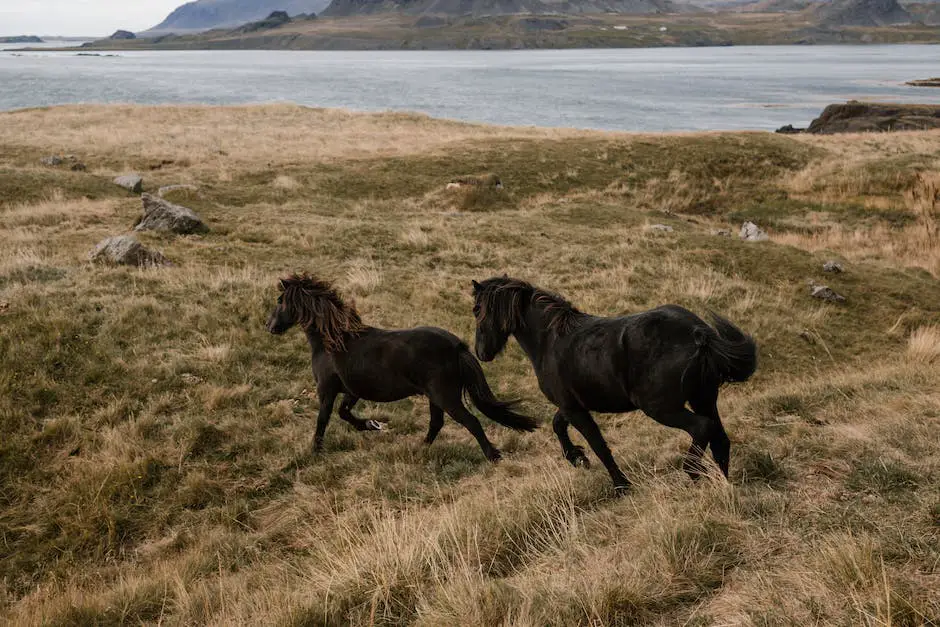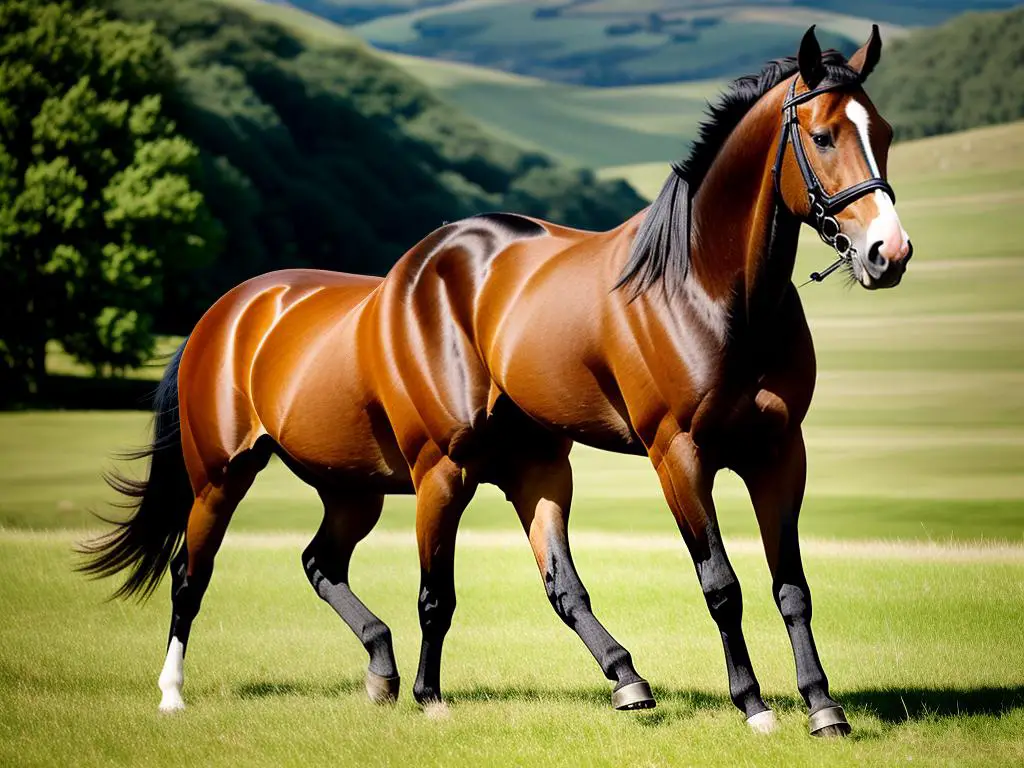Welcoming a journey into the fascinating world of the Merens Horse, this exploration invites you to gain a profound understanding of these majestic horses. Born from the rugged terrains of the Pyrenees Mountains, the Merens Horse carries a rich history, with a lineage that profoundly intertwines with the agricultural significance of past eras. Painted in an enchanting black hue, their distinguished characteristics, and commendable abilities serve as cornerstone traits for this compelling breed. Each element from their intriguing origin, remarkable characteristics, meticulous care routines, to their standing in today’s world speaks volumes about their unique appeal. So saddle up, as this voyage promises to kindle a newfound respect and admiration for the Merens Horse.
Table of Contents (Horspedia)
Origins and History
Origin and History: Tracing the Merens Horse roots back to Pyrenees Mountains.
Mérens horses, also known as Ariégeois ponies, have their origins rooted in the Pyrenees mountains of Southern France. Ancient breed, these horses have been historically recorded as being in the region since at least the prehistoric era, based on cave paintings found in the Ariège department. They are named after the village of Mérens in Ariège, located within their primary habitat.
A Journey through time: From war steeds to agriculture
Throughout history, Merens horses have played versatile roles, shifting from war horses during the Roman period to prolific workhorses in agriculture. They were employed by Roman legions for their outstanding hardiness and adaptability to harsh climates. Centuries later, during the Middle Ages, they were commonly used by knights, reflecting their enduring strength and compact size.
Their role in agriculture largely started in the 19th century. Mérens horses were commonly used for farming tasks, particularly in hilly or mountainous areas, thanks to their hardiness, docility, and adaptability. They demonstrated their ability to work long hours on limited feed, making them an indispensable asset in such challenging terrain.
The Evolution: From workhorses to leisure horses
With the advent of industrialization, the need for workhorses, including the Merens, declined dramatically, pushing the breed to near extinction. However, their fortunes began to change in the mid-20th century. A renewed interest in maintaining regional heritage and preserving local horse breeds led to concerted efforts to recover the Merens population.
Today, the Merens horses have successfully transitioned from being primarily workhorses to popular choices for leisure and competitive activities. They’re widely used for riding, for trekking, and even for dressage and jumping because of their robust build, sure-footedness, and steady temperament.
Moreover, their striking appearance — compact, muscular build with a beautiful black coat — has also contributed to their increased desirability among modern horse enthusiasts.
Current Significance
In modern times, the Merens horses have evolved from being mere symbols of regional pride and historical heritage to playing pivotal roles in recreational and sporting activities. These horses, renowned for their resilience, tranquil nature, flexibility, and distinct black coats, are thoroughly admired. Their sturdy build, minimal upkeep, and hearty health – a result of their historical mountainous lineage – make them a great choice, especially for novice horse owners.
Their unshakeable reputation extends to therapeutic riding programs, where their tender disposition and forbearance are crucial. This progression in their role from the past till now indicates their adaptability, making them one of the most intriguing and enduring horse breeds globally.

Characteristics and Abilities
Introduction: Exploring the Unique Merens Horse
Originating from the French Pyrenees, the Merens Horse breed occupies a special spot in the equine world. These sturdy and versatile horses are recognized for their adaptability and sustained stamina, specifically in mountainous landscapes.
Distinct Physical Characteristics
Merens Horses are compact and sturdy, typically standing between 14.1 and 15.3 hands high, making them a medium to small-sized breed. Despite their modest size, they boast remarkable strength and possess a stocky and well-muscled frame. Comfortably carrying riders through challenging trails, they are the embodiment of the saying, “big things come in small packages.”
Their coat is exclusively black, a trait that is strictly maintained to each successive generation, giving them a striking and formidable appearance. The darkness of their coat, combined with their lush manes and tails, offers an enchanting contrast to the often snowy settings in which they thrive.
Additionally, they have a broad chest, strong neck, and a well-defined jawline. Their eyes are not simply the windows to their souls, but they reflect their calm and compassionate demeanor. In winter, their coat matures into a plush layer, providing requisite insulation against the chilly weather.
Nature and Temperament
Beyond their physical attributes, Merens Horses are recognized for their innately gentle disposition. They are known to be serene, cooperative, and extremely trustworthy, attributes appreciated by both amateur riders and professionals alike. Their steadfastness and calmness especially shine through when faced with nerve-wracking situations, making them a favorite breed for equine therapy.
Adaptability and Abilities
Merens Horses flourish in diverse environments but primarily excel in mountainous terrains. This innate mountain adaptability not only demonstrates their physical hardiness but also their intelligence and agile thinking skills when negotiating challenging paths.
They are elite when it comes to endurance. Historically, they were deployed for pulling carriages, farm work, and even in warfare, tasks that demanded physical strength and mental grit over extended periods. Even today, they are commonly used in trekking and trail riding across the arduous mountainous routes due to their resilient nature and ability to conserve energy over long distances.
A Close Look at the Merens Horse
Renowned for their glossy black coats and spirited yet gentle temperament, the Merens Horse breed beautifully blends physical strength with a remarkable aesthetic appeal. These horses are particularly sought after for their adaptability and versatility, especially in treacherous high-altitude terrains. Additionally, their calm demeanor coupled with impressive intelligence, strength, and stamina, truly sets them apart as an incomparable equine breed.

Care and Maintenance
Nurturing a Merens Horse: Understanding Their Dietary Demands
To maintain the Merens Horse’s optimal health, their diet must offer a well-balanced mix of forage, grains, and nutritional supplements. Their main forage typically comprises pasture grass and hay. However, due to these horses’ less intense activity levels compared to other breeds, they need a smaller portion of grains. Overfeeding can lead to obesity as these horses have a slower metabolism.
While fruits, vegetables, and treats tailored for horses can be allowed in moderate quantities, it’s critical to regulate these to fend off unwanted weight gain. Equally vital is ensuring adequate water intake, as lack of hydration can profoundly affect a horse’s wellbeing.
Grooming Needs: Promoting a Healthy Coat and Hooves
To maintain the Merens Horse’s beautiful black coat, regular grooming is essential. Daily brushing removes dirt, dust and prevents matting. During molting seasons, typically in the spring and fall, more rigorous brushing is needed to remove the excess hair.
Aside from skin and coat care, attention should also be given to their hooves. Hooves should be cleaned daily and checked for any signs of injury or infection. Trimming should be done every four to six weeks, by a professional farrier, to prevent overgrown or uneven hooves.
Exercise Routines: Keeping Your Merens Horse Active
Merens Horse, while being a calm and docile breed, still require regular exercise to maintain their health and happiness. Their exercise routine should include both cardiovascular workouts, such as trotting and cantering, and strength-building activities like pulling or weight carrying.
When exercising a Merens Horse, consider its age, health condition, and daily workload. Older horses or those with health issues may require lighter workout regimes, while active, healthy horses can endure and benefit from more rigorous workouts.
Health Care: The Importance of Routine Vet Checks
Routine veterinary care is critical to keeping a Merens Horse healthy. Vaccinations, deworming, and dental care should not be overlooked. Regular check-ups will also pick up any early signs of common equine conditions, such as laminitis or colic, and your vet can advise an appropriate course of action.
Understanding that each Merens Horse is unique, with specific care and maintenance needs, is key to owning one. This breed doesn’t fit a one-size-fits-all approach, therefore it’s vital to be aware and responsive to the individual needs of your Merens Horse.

Merens Horses Today
Present-Day Merens Horses: Their Role, Popularity, and Conservation Measures
Increasingly gaining popularity today, the Merens Horses, also known as the Black Prince of the Mountains, are admired in the sport and leisure industry. Their solid black coats and tenacious yet placid nature make them standout. Originating from the heart of the French Pyrenees, they are highly versatile, effectively participating in equestrian events, performing farm work, and acting as dependable companions for leisure riding.
The Merens Horse breed is recognised in dressage, eventing and driving competitions around the world. Their strong build and nimble movements make them a firm favourite among equestrian aficionados, especially when it comes to cross-country and endurance riding. With their steady gait and temperament, they are an excellent choice for youngsters and beginners learning to ride and participating in outdoor equestrian activities, especially in mountainous or challenging terrains.
Speaking of their conservation status, the Merens Horse is not in danger, with initiatives in place to maintain and boost its numbers. It’s estimated that there are about 2,500 to 3,000 of Merens Horses in France and an additional 600 worldwide with many being purebred Merens registered with breed societies.
Over recent years, the focus on the preservation and promotion of the Merens Horse breed has seen a significant increase. The French National Stud Facilities have introduced conservation breeding programs to support the breed’s integrity. These efforts centre on promoting genetic diversity, substantially reducing inbreeding, and employing natural breeding strategies. Meanwhile, breeders’ associations and societies strive to generate awareness about the breed and encourage responsible ownership.
Additionally, annual events such as the Transhumance Festival display and highlight the breed. The event involves herds of Merens Horses trekking from summer pastures higher up in the mountains to lower valleys, showcasing the breeds’ impressive endurance and beauty.
It’s noteworthy that the trend of establishing conservation programs is now seen outside of France which indicates a surge in global interest in conserving this precious breed. The longstanding history and significant role of the Merens Horse breed in French rural life led to its recognition as a heritage breed.
As environmental sustainability takes center stage, the Merens Horse’s robust nature and minimal requirements make them an appealing choice for environmentally-friendly and economical horse-keeping. This value proposition further drives the promotion and conservation of this remarkable breed.

Having traced the lineage of the Merens Horse to their roots in the Pyrenees Mountains, delved into their striking characteristics and abilities, discussed their detailed care routines, and considered their standing in today’s world, it becomes clear that these noble creatures hold a significant role in equine heritage. Their quiet strength and resilience paired with their undeniably captivating aesthetic and endearing nature, make them a fascinating breed worthy of our admiration and respect. Despite the challenges they face, efforts to preserve and promote the Merens Horse continue steadfastly, echoing the undying spirit of this outstanding breed. The journey into the world of the Merens Horse leaves us not only informed but also deeply entranced by this incredible equine breed.